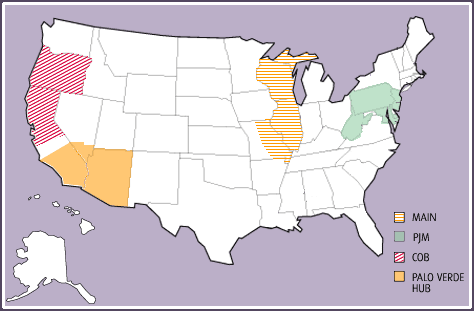 |

The crux of the current energy crisis lies in the conflicting regulations
governing wholesale markets and retail markets. Deregulation lifted
controls in the wholesale markets while retaining price caps on retail rates.
As a result, when prices shot up on the wholesale market, utilities were unable
to pass on these rate increases to the consumer and were forced to take a loss.
This drove PG&E into bankruptcy in California.
The wholesale markets existed even before deregulation. However, before access
to transmission lines was opened, the trade was constrained. Since then, the
number of companies participating in the market has grown considerably and
trade takes place similar to other commodity futures, with transactions
typically including daily, monthly, and long-term contracts for energy supply.
The regions for which these contracts are made are delineated by the power grid
and the major transmission lines, regions which don't correspond exactly to
state lines. For example, Southern California is covered by the Palo Verde
Hub, based around the Palo Verde nuclear power station in Arizona, and the
market which supplies Northern California is classified as the
California/Oregon Border. Therefore, conditions in one state can affect areas
beyond its borders.
Price fluctuations on the wholesale market don't immediately affect residential
rates, mostly because temporary price caps have remained in place to cushion
the transition to a fully deregulated marketplace. Therefore, in much of the
country, residential rate payers have been insulated from wholesale market
price spikes. In San Diego, the first city where price caps were lifted,
retail rates immediately shot up once they were freed. As caps are lifted in
other parts of the country, similar price jumps can be expected.
Four representative wholesale power markets are depicted on this map.
They are the Palo Verde Hub in the Southwest, the COB (California/Oregon
Border) in the Northwest, the MAIN (Mid-America Interpool Network) in the
Midwest and the PJM (Pennsylvania/New Jersey/Maryland) in the
Mid-Atlantic. These four areas were chosen to illustrate how deregulation
of power markets has affected various areas of the country differently.
Click on the map to find out more about how deregulation has affected the
wholesale markets in that region and what the effect has been on consumers'
bills.

home - california - my bill - new business - regulation - the future - new york times reports
video - interviews - glossary - discussion - synopsis - press - tapes & transcripts - credits
FRONTLINE - wgbh - pbs online
power lines photo ©2001 entropy media/images
web site copyright WGBH educational foundation
|  |